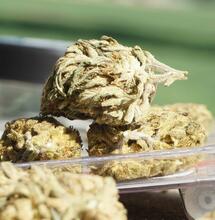The Drug Factory that is Cannabis

The summer of 2012 marked a revolutionary discovery in the field of medical Cannabis: scientists at the University of Saskatchewan discovered the exact pathway used by the plant to produce its plant drugs, known as 'cannabinoids'.
The summer of 2012 marked a revolutionary discovery in the field of medical Cannabis: scientists at the University of Saskatchewan discovered the exact pathway used by the plant to produce its plant drugs, known as 'cannabinoids'.
The summer of 2012 marked a revolutionary discovery in the field of medical Cannabis: scientists at the University of Saskatchewan discovered the exact pathway used by the plant to produce its plant drugs, known as 'cannabinoids'. These findings were published in July in the online version of Proceedings of the National Academy of Sciences (PNAS). As the chemical pathway established by Cannabis is an unusual one, it is no surprise that scientists still have much research to attempt in order to understand the exact botanical processes required to create these helpful plant drugs.
This recent discovery enlightened the scientific community, as Cannabis has taken “a rare fatty acid with a simple, six-carbon chain and use[d] it as a building block to make something chemically complex and pharmacologically active,” according to Jon Page, adjunct professor of biology at the university. Page, along with Ph.D. student Steve Gagne and post-doctoral researcher Jake Stout, revealed that the pathway involves a rare enzyme, known as hexanoyl-CoA synthetase, discovered by Stout himself. Gagne is credited with identifying olivetolic acid cyclase (OAC), the other necessary component. Genomic analysis was applied to catalogue the genes in certain 'trichome' cells.
These days, scientists – and many ganja enthusiasts – are aware that differing drug action results from consumption of different cannabinoids in various ratios and combinations, produced in the trichomes of female plants. This is why you feel 'high' and happy from the sativa and haze strains, and 'stoned' and sleepy from the indicas. The trichomes, oily resin glands shaped like tiny mushrooms on tall stalks, are generally what make your fingers sticky, and a collection of these with little vegetable matter is known as hash, skuff, kief or polm. The trichomes protect weed plants against winged predators and other infestations, and their viscous nature aids in wind pollination, hence their abundance on female Cannabis flowers.
In addition to the myriad medical and recreational applications that Cannabis offers, it may now be possible to synthesize or breed these helpful cannabinoids in order to produce drug-specific strains of weed, allowing doctors and patients to focus upon one or a set of cannabinoids that will tailor the therapy into a specific treatment for that patient's ailments. Additionally, scientists have already successfully attempted to stimulate other organisms and plants to also produce cannabinoids, especially those that do not do so naturally – such as yeast. According to Page, “Now that we know the pathway, we could develop ways to produce cannabinoids with yeast or other micro-organisms, which could be a valuable alternative to chemical synthesis for producing cannabinoids for the pharmaceutical industry.”
On the other end of the spectrum, industrial hemp stock may be more easily selected and less likely to genetically slide towards the higher THC content of smoke-able weed, thereby stimulating the industrial hemp industry in countries such as Canada, while keeping the farmers safe from prosecution.
For more information, check out Cannabis 'Pharma Factory' Discovered (July 16, 2012) at www.sciencedaily.com.



